The first photographs that were taken by SECONDO PIA in 1898 showed the positive image of a man on the negative glass plates that he used, and also showed that the original image on the Shroud had the properties of a photographic negative. This aroused the interest of the scientific community and from that moment on the Shroud became the most investigated artifact in the world. One of these scientists, in the early part of the 20th century was PAUL VIGNON from the University of Paris, and he spent quite some time investigating the Shroud. One of his observations was, that the image on the Shroud varied inversely with the cloth-to-body distance, which means that the parts of the body that were close to the cloth, were imaged darker than the parts that were further away. The density of the image is proportional to the distance between the body and the cloth and that is caused by the fact that more fibers per square unit are discolored. This translates to 3D information encoding of the image in the grayscale of the photographs of the Shroud. VIGNON could not prove his observations scientifically.
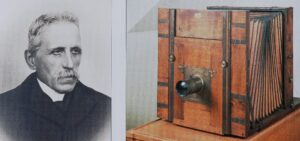
Secondo Pia 1898
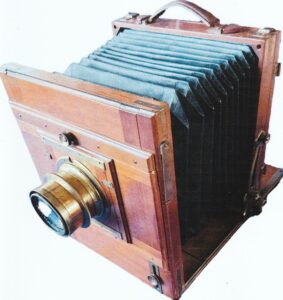
Voigtlander Camera used by Pia |
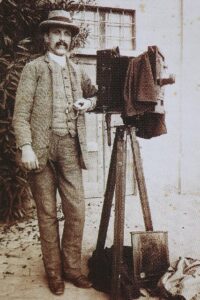
Secondo Pia with camera |
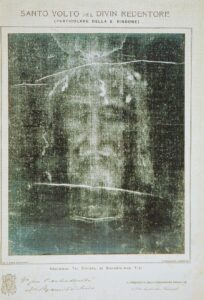
Photograph face S. Pia |
In the fifties of the last century, LEO VALA, a professional photographer in London, did the first 3-dimensional experiments with the image on the Shroud of Turin. Vala employed a process that he called the Transflex Process of front projection. Using two positives of the 1931 Shroud photographs of the head, made by Giuseppe Enrie, and then projecting them on a bed of clay, using two projectors to create the matrix for a sculpture. After that he could sculpt the head. The result was quite stunning and showed the complete face image with lots of detail.
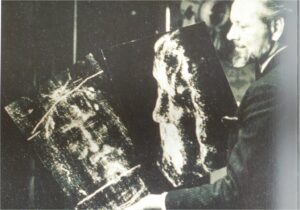
3D study Leo Vala
Another person that experimented with the 3D qualities of the Shroud image was BARBARA M. SULLIVAN and she published her results in 1973 in the National Review in an article titled: “Reading the Shroud of Turin: Climax Approaching”.
In 1974 a Frenchman, Ing. PAUL GASTINEAU, made a negative relief mold using his own system. This technique consisted in having every single point on the Enrie photograph of the face examined using his own equipment and a concentrated light source; the measurements of the quantity of light which was more or less reflected was transmitted to another part of the instrument , which contained a white-hot point that at the same time engraved the image into a soft material, thus visualizing this hidden information and obtaining a three dimensional Sindonic face.
The next step in the studies of the 3D characteristics was done by Captains JOHN P. JACKSON, a physicist, and ERIC JUMPER, of the United States Air Force Academy. After conducting a series of measurements of image density and comparing the cloth-to-body distance with these intensities on different locations of the Shroud image, they created a graphic record with a microdensitometer, of the relationship of the image intensity with the cloth-to-body distance and came to the conclusion that PAUL VIGNON’S observations were correct.
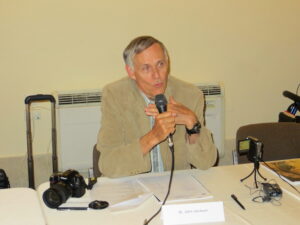
John Jackson |
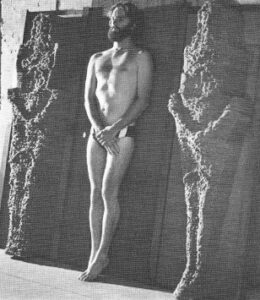
3D study Jackson & Jumper |
After that they contacted in 1976 in Colorado Springs, PETE SCHUMACHER, who had developed the Interpretation System VP-8 Image Analyzer. This is an analog video processing device which processes monochromatic images (2D images) and converts the various luminance levels into a hypothetical height corresponding to those luminance levels, thus forming a vertical relief.
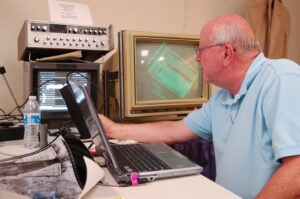
Pete Schumacher with VP-8 Image Analyser
The primary interest to Shroud of Turin research was the isometric projection display which mapped the brightness variations within the video images. The VP-8 image analysis revealed that a photograph of the Shroud image was “spatially encoded”, i.e., it possessed depth information and resulted in anatomically correct 3D images of the face and the body. So now they had the scientific proof that the observations of Paul Vignon were correct. It is important to note, that they experimented with lots of photographs of faces and other images, including paintings, and that the result always was a distorted image, with flattening of the relief, including the arms within the chest and the nose pressed into the face. They also concluded that there seemingly was no forgery involved, because their 3D images showed absolutely no brush stroke marks, which an artist would have produced.
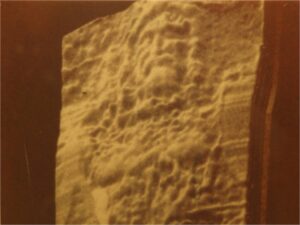
3D body and face VP-8 |
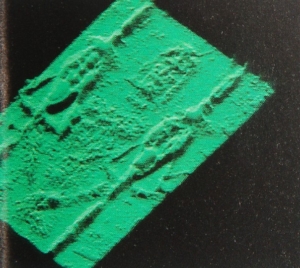
3D body VP-8 |
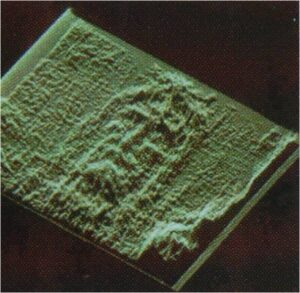
3D face VP-8 |
The age of the computer studies of the 3D qualities of the Shroud image had started and the challenge was taken up by others. Prof. GIOVANNI TAMBURELLI (CSELT, Turin, Italy) did computer research in the seventies of last century and obtained remarkable 3D images of the face and the body. He also produced an artistic version of the face using special filters (recursive) that eliminated the irregularities in the face (wounds and swellings), and called it “the probable photograph of Jesus Christ”. Prof. NELLO BALOSSINO of Turin must also be mentioned with computer research of the image.
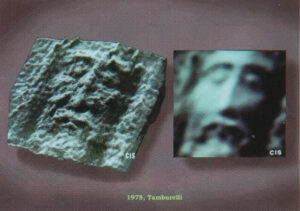
Giovanni Tamburelli 3D face
The studies done by ALDO GUERRESCHI and Prof. ALAN WHANGER that resulted in the development of the photo relief technique are also worth mentioning. What they did was as follows. By placing one film over and on top of another, one negative and the other positive, and then off-setting the films in relation to each other, they were able to create an effect of alternating light and shadows of the image that gave the impression of relief, in this case pseudo-relief. By offsetting the films to the right or the left or more to the top or the bottom, they created a very impressive, detailed pseudo 3D of the face and the body.
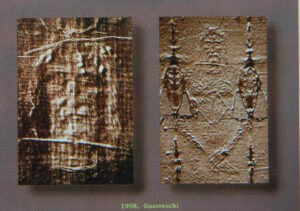
3D face Aldo Guerreschi |
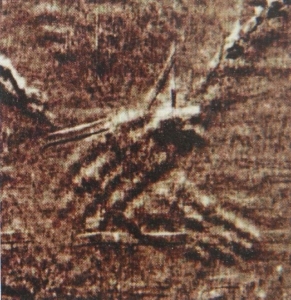
3D hands Aldo Guerreschi |
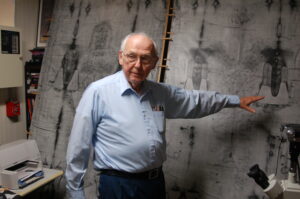
Alan Whanger
In 2000 in Italy, GIULIO FANTI (Department of Mechanical Engineering, University of Padua) and Shroud scholar EMANUELA MARINELLI (Collegamento pro Sindone) published the result of a study based on the analysis of the three dimensionality of the body image. “ A Study of the Front and the Back body enveloping based on 3D information “. Their conclusion was, that the man was not enveloped with bandages. The sheet was simply laid on the outstretched body, which was in a position equal to the one taken on after the death on the cross because of the rigor mortis, except for the arms where the rigor mortis was “broken”.
Then in 2005 Dr. PETRUS SOONS, aware of the fact that there was hidden 3D information in the grayscale of the image of the body of Jesus, used this information, and with his team of experts he recreated the body in 3D in the computer, and this information was then used to create Holograms (3D images in LIGHT) of the Shroud including the 3D image of the face and the front and the back of the body. In 2006 these holograms were produced with the original measurements (200 x 100 cm) in the Shroud. They also produced Anaglyph 3D images and 3D Lenticulars for use in conferences and expositions. Lenticulars are basically 3D photographic images covered with a plastic sheet containing thousands of little lenses and they show the 3D remarkably well.
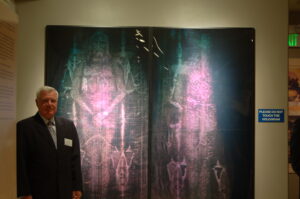
Dr. Petrus Soons in front of Life Size Holograms, Sacramento, USA
In 2010 Ray Downing produced for the History Channel a documentary titled: “The Real Face of Jesus”. He showed in this movie the 3D characteristics of the Shroud image and how he could reproduce an artistic version of the face of Jesus based on the 3D information in the grayscale of the image. The reactions on this documentary were very positive. The physicist John Jackson was one of the experts on 3D in this production.
The computer studies confirm the 3-dimensional origin of the Shroud image and show a lot of details that previously had not been seen in the photographs of Enrie and others. We can expect much more from these computer studies in the future with more powerful and faster computers and specially the 3D computer techniques that are evolving also at a great speed.
